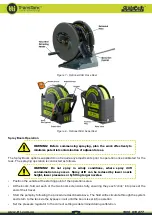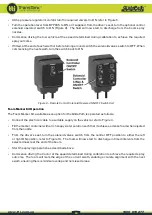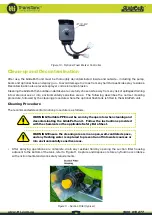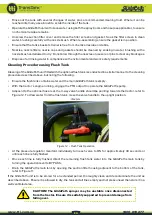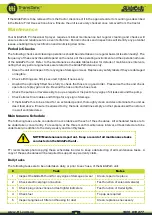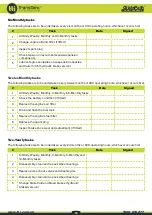
1800 816 277
www.tti.com.au
9
Product HandBook
GlidePath
™
PPE appropriate to the chemicals being used must be worn at all times when calibrating the GlidePath. As a
minimum, the PPE should include coveralls, gloves and boots. A face shield and PVC apron are recommended.
Calibration Procedure
Check the label on the chemical container for the application rate and recommended spray nozzle type, refer
to Figure 2, which shows the TeeJet AIXR nozzle application chart. To apply a specific rate of chemical to the
target surface, work out the:
• total sprayer output,
• travel speed, and
• the swath width.
Using these parameters, the application rate is calculated as follows.
Measure Total sprayer output [L/min]
Set the pressure at the correct level for spraying determined by the type of nozzles. All nozzles used for
spraying should be left on. For initial trials, set the pressure regulator at approximately 2 bar and adjust as
needed.
•
Fill the spray tank with clean water, refer to Filling the GlidePath Tank procedure below. Run the sprayer at
the correct pressure with all nozzles operating.
•
Place a measuring jug under first nozzle for one minute, then measure how much water is in the jug.
•
Repeat for all nozzles. Nozzle output should not vary by more than 10%. If it does, the nozzle could be
worn or damaged and should be replaced.
•
Add all the jug measurements to find the total sprayer output in litres per minute.
Measure the travel speed [km/h]
The normal speed for spraying with small boom sprayers is 4–10 km/h. The slower the travel, the higher the
application rate. Adjust travel speed to suit ground conditions.
•
Measure how many seconds it takes to travel 100 metres with the sprayer attached and half full.
•
Calculate your travel speed by inserting the time in seconds into the following formula:
Travel speed (km/h)
= distance travelled in metres (say 100m) x3.6 / Time taken (in seconds)
Calculate spray application rate [L/Ha]
First, measure the swath width in metres. For general broadcast spraying, the swath width is equal to the
number of nozzles multiplied by the nozzle spacing. For band spraying, the swath width is equal to the total of
all the band widths. Calculate the application rate using the following formula:
Application rate
(L/ha) = (600 x total sprayer output (L/min)) / (swath width (m) x travel speed (km/h))
Example: If total sprayer output is 5 L/min, speed is 8 km/h, and swath width is 4m, the application rate = (600
x 5 = 62.5 L/ha)/(4 x 8)
If the application rate is less than specified, increase the pressure and repeat calibration to achieve the correct
rate. Once the required rate is achieved, note the following parameters for future reference when using this
particular chemical:
• Nozzle Fitted
• Type (Drop Size)
• Application Rate
• Spray Pressure
• Forward Speed.

















